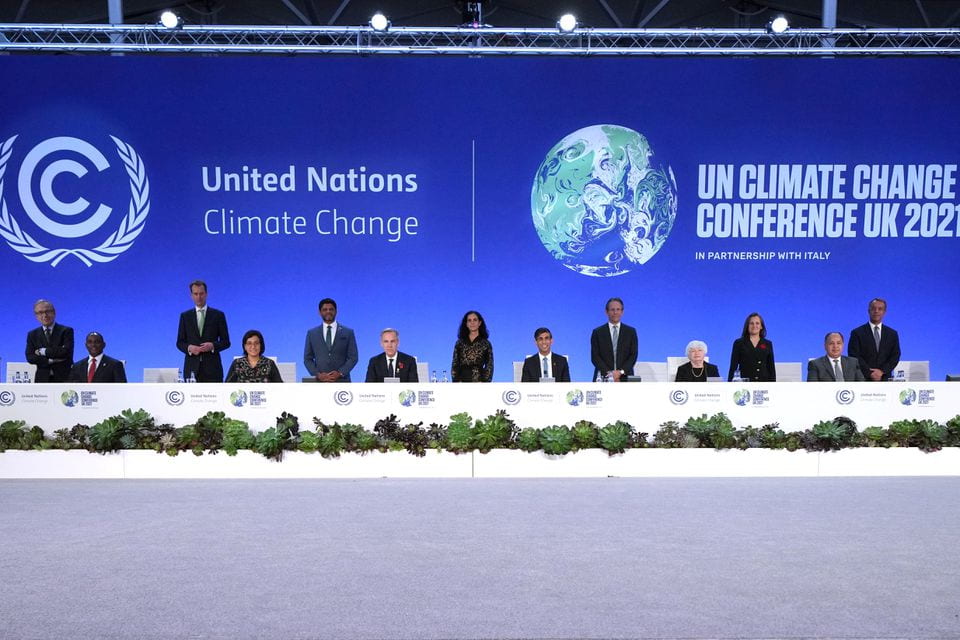The 26th United Nations Climate Change Conference (COP26) recently concluded. Running for two weeks in Glasgow, Scotland, leaders from 200 nations worldwide came together to review and advance goals related to humanity’s response to climate change and create the Glasgow Climate Pact. Delayed a year due to the COVID-19 Pandemic, COP26 was a check-in on the commitments of the Paris Agreement from 2015’s COP21. The Paris agreement consists of 195 countries pledging to keep global average temperatures below 2 °C (35.6 °F) compared to pre-industrial levels, with the target of limiting warming to 1.5 °C (34.7 °F). Meeting this 1.5 °C commitment significantly reduces and eliminates many of the more severe risks and impacts from climate change. Each country is responsible for determining and achieving its own contributions to meeting the 1.5 °C goal, called nationally determined contributions. These conferences aim to increase accountability for nationally determined contributions within and between nations.
COP26 was an opportunity for world leaders to respond to 1) the latest scientific reports confirming the critical timeframe to take impactful steps and 2) the overall lack of action regarding the Paris Agreement. Consequences are already being felt in our backyards with severe drought, heatwaves, flooding, cold snaps, and extreme storms—decisions made at COP26 influence what happens in our neighborhoods for current and future generations.

Many speeches were given by world leaders, respected public figures, scientists, and activists. But at the end of the day, what was tangibly accomplished? Here are the main takeaways:
1) The Glasgow Pact reaffirms the 1.5 °C target. It is the first climate deal that explicitly acknowledges the scientifically-recognized attribution of fossil fuels on warming temperatures and specifically requires eliminating coal-burning done without any carbon capture or storage in the near future; however, a timeline for phasing-out nonrenewable energy was not achieved. Meeting the 1.5 °C target requires reducing greenhouse gas emissions by a minimum of 7% every year, which is significantly faster than the drop seen during the pandemic’s zenith in 2020.
2) A total of 100 countries agreed to stop deforestation by 2030, which is not fast enough to suitably enhance carbon sequestration in soils and trees by 2050 nor preserve biodiversity and ecosystem resilience.
3) A total of 100 countries also agreed to eliminate 30% of current methane emissions by 2030. Methane is a greenhouse gas with a greater warming potential than carbon dioxide. While it has a shorter lifespan in the atmosphere, it chemically degrades into carbon dioxide. This double-whammy means the current reduction agreement misses the larger picture: it only considers current emissions and not new ones from melting permafrost and feedbacks from overall warmer temperatures in the coming years.
4) A total of 450 financial groups that collectively control $130 trillion have agreed to move away from fossil fuels and begin financing renewable energy technology with a focus on supporting developing countries.
5) Indigenous and human rights were integrated into Article 6 under the Paris Agreement, although without any legally binding responsibility to comply.
The proceedings can be summarized as a step to limit warming to 1.5 °C but falls short of meeting the goal. The main cause of climate change is the use of fossil fuels, with 86% of all carbon dioxide emissions in the last ten years being from coal, oil, and gas. Fast-tracking the transition to viable, safer, and more cost-effective alternatives is of paramount importance. The Glasgow Pact is well below the requirements to limit temperatures to 1.5 °C.

Climate Action Tracker, a research cohort monitoring progress on greenhouse gas emission reductions, released a report detailing how COP26 pledges will, at best, only reduce warming to 2.7 °C (36.9 °F). The annual Emissions Gap Report from the United Nations Environmental Program independently confirmed these findings. Both reports base their projections on publicly available nationally determined contributions from the 40 countries collectively responsible for 80% of the world’s greenhouse gas emissions. Nationally determined contributions must be resubmitted every year by each country, but there is a wide range in quality. Some plans outline specific steps to meet targets. In contrast, others are unabashedly vague. These reports look at the current collective picture to rank and determine what impact each nationally determined contribution has.
The final consideration is that COP26 has no overarching authority or ability to enforce commitments (unlike the Montreal Protocol) and instead acts as a venue where transparent negotiations can occur between world leaders with a healthy dose of peer pressure. Promises about reducing emissions have little to do with what was said in Glasgow and more to do with what’s done domestically, which is an entirely different political wormhole.
Climate promises and the intent (or lack thereof) to keep them are important controls on what our climate future looks like. One challenge of projecting how climate change may impact water resources is understanding how the global community will respond. Limiting warming to 1.5 °C seems more and more out of reach, but hopefully, the 2.7 °C projected for COP26 pledges will come down as societies react to the growing seriousness of climate impacts.
The world will gather again in Egypt next year at COP27 to focus on equitably strengthening nationally determined contributions.
Check out these links to read more: